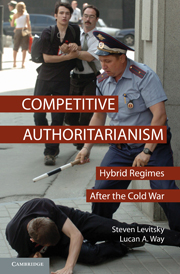Book contents
- Frontmatter
- Contents
- Acknowledgments
- Acronyms and Abbreviations
- Part I Introduction and Theory
- Part II High Linkage and Democratization: Eastern Europe and the Americas
- Part III The Dynamics of Competitive Authoritarianism in Low-Linkage Regions: The Former Soviet Union, Africa, and Asia
- 5 The Evolution of Post-Soviet Competitive Authoritarianism
- 6 Africa: Transitions without Democratization
- 7 Diverging Outcomes in Asia
- 8 Conclusion
- Appendix I Measuring Competitive Authoritarianism and Authoritarian Stability
- Appendix II Measuring Leverage
- Appendix III Measuring Linkage
- Appendix IV Measuring Organizational Power
- References
- Index
6 - Africa: Transitions without Democratization
Published online by Cambridge University Press: 05 June 2012
- Frontmatter
- Contents
- Acknowledgments
- Acronyms and Abbreviations
- Part I Introduction and Theory
- Part II High Linkage and Democratization: Eastern Europe and the Americas
- Part III The Dynamics of Competitive Authoritarianism in Low-Linkage Regions: The Former Soviet Union, Africa, and Asia
- 5 The Evolution of Post-Soviet Competitive Authoritarianism
- 6 Africa: Transitions without Democratization
- 7 Diverging Outcomes in Asia
- 8 Conclusion
- Appendix I Measuring Competitive Authoritarianism and Authoritarian Stability
- Appendix II Measuring Leverage
- Appendix III Measuring Linkage
- Appendix IV Measuring Organizational Power
- References
- Index
Summary
“It is better to be President in a nondemocratic country than not to be President in a democratic one.”
– Advisor to Frederick Chiluba, President of ZambiaThis chapter examines 14 competitive authoritarian regimes in Africa. The African cases share several features in common. First, they lacked favorable conditions for democracy. Nearly all of them were poor, rural, and had small middle classes and weak civil societies. Notwithstanding episodes of mass protest in some cases, large or sustained democracy movements were rare. Second, most African states faced an external environment characterized by high leverage and low linkage. Sub-Saharan African states were among the weakest and most dependent in the world, and the disappearance of competing Western security interests after the Cold War brought a sharp increase in external democratizing pressure. In 1990, the United States, United Kingdom, and France announced that future aid to Africa would be linked to democratic and human-rights performance. The new political conditionality had a major impact: The number of de jure single-party regimes in the region fell from 29 in 1989 to zero in 1994.
At the same time, transitions took place in a context of low linkage. Africa's economic ties to the West were minimal, and information flows to and from the region were limited. In the early 1990s, Africa had the lowest density of telephone lines in the world, lacked virtually any internet connections, and was “severely underrepresented” in transnational human-rights networks.
Information
- Type
- Chapter
- Information
- Competitive AuthoritarianismHybrid Regimes after the Cold War, pp. 236 - 308Publisher: Cambridge University PressPrint publication year: 2010
